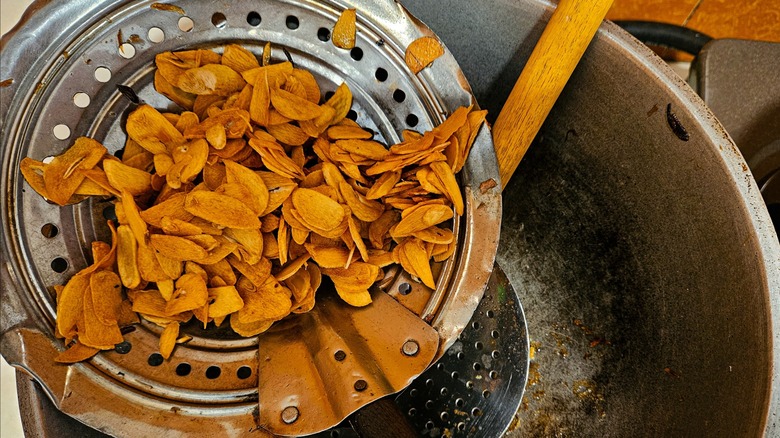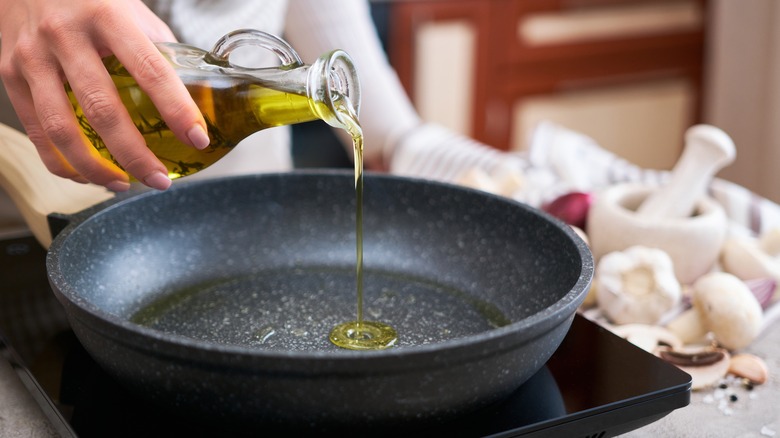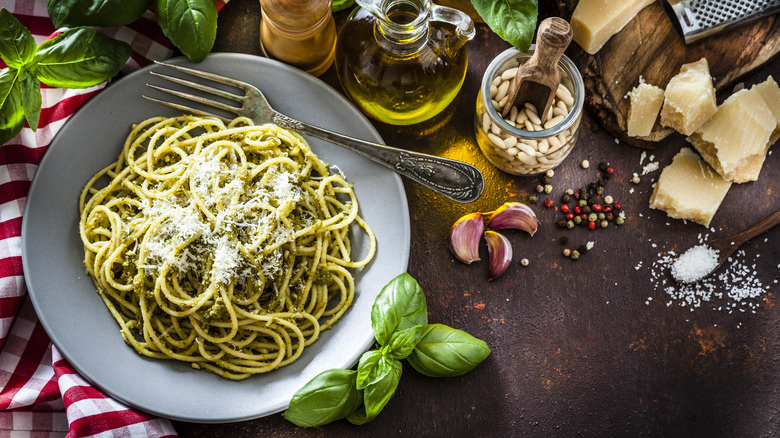Why Cold Oil Is Essential For Perfectly Crisp Garlic Chips
You know the scene. You've heated up a pool of oil in a pan, so that tiny bubbles are forming at the edges, and then you toss in some minced or sliced garlic cloves. The garlic sizzles loudly, but before you can even breathe in the rich aroma, its color starts to turn darker and darker. Pieces of the garlic begin to burn and turn black and acrid before you can even think to save them.
This is an all-too-common kitchen occurrence, and an easy mistake to make when using garlic. It's even worse if you're making garlic chips, those crisp and delicious slices of fried garlic that can be used to garnish countless dishes — but ultimately, this ingredient stands on its own, making any burnt flavors extremely obvious. When overcooked garlic becomes harsh and acrid, its nutty sweetness is replaced by a bitter edge, which doesn't do any favors for your food.
When garlic is sliced thinly (often using a mandoline) for garlic chips, burning can happen before you know it. The fix is starting cold, not hot. Placing the sliced garlic in a cold pan full of cold oil gives you more control, lets the chips cook more slowly and evenly, and imparts a fuller flavor. Every chip will reach that crisp, golden color you're looking for, without having to sacrifice any to accidental scorching.
Some ingredients like it cold
Starting with a hot pan is good for some ingredients, especially proteins like meat. However, for ingredients that easily overcook, it can be better to bring your food, pan, and oil up to temperature at the same time. Ingredients like herbs and spices, as well as garlic, will burn when they meet sizzling hot oil, and slowly heating them gives you more control over their cooking.
For aromatics like garlic and onions, the cold oil method also improves flavor. When you chop or slice garlic, you break down their cell walls. Inside these garlic cells are a compound called alliin and an enzyme called alliinase. When those two come into contact (thanks to your slicing), the resulting chemical reactions produce delicious, garlicky flavor compounds.
However, too much heat deactivates alliinase so that it doesn't react properly with alliin, thus dulling the flavor of your garlic chips. Raw garlic is quite sharp, so taming the strong flavor is usually a good thing, but too much heat will kill it. Starting your thin garlic slices in cold oil limits excessive heat exposure and allows you to slowly cook the chips to the ideal crispness, without a lackluster or acrid flavor. Watch for a golden brown color, and the moment your chips attain that shade, scoop them out of the oil and you're done.
How to use garlic chips as an all-star condiment
Garlic chips are well worth the extra time spent cooking them gently. Since the garlic's alliinase has been somewhat deactivated by cooking, the flavor of the chips isn't sharp or overwhelming, but instead mellow, nutty, and rich. The chips can be sprinkled onto any dish that would benefit from a fragrant, subtle garlicky sweetness. They're also perfect for adding texture and complexity with their crispy, crunchy texture.
Put garlic chips on top of a simple water spinach salad, or any other salad that needs a little flavor and texture boost. Garlic chips will take rice bowls or fried rice to the next level, and can even elevate pasta dishes that can stand up to the garlic flavor. Soups or stews can always use a crunchy garnish as well, but you shouldn't be surprised if you find yourself just eating garlic chips by the handful.
As a final tip, you should use vegetable oil rather than olive oil for frying the garlic. Cooking garlic chips in a neutral oil, rather than a more flavorful fat like olive oil, is the best way to keep the condiment as versatile as it can be. It helps the garlic flavor shine, with no distractions.


